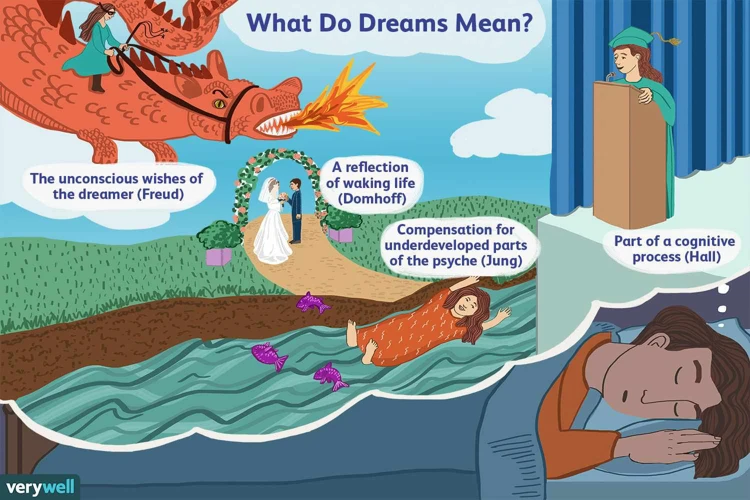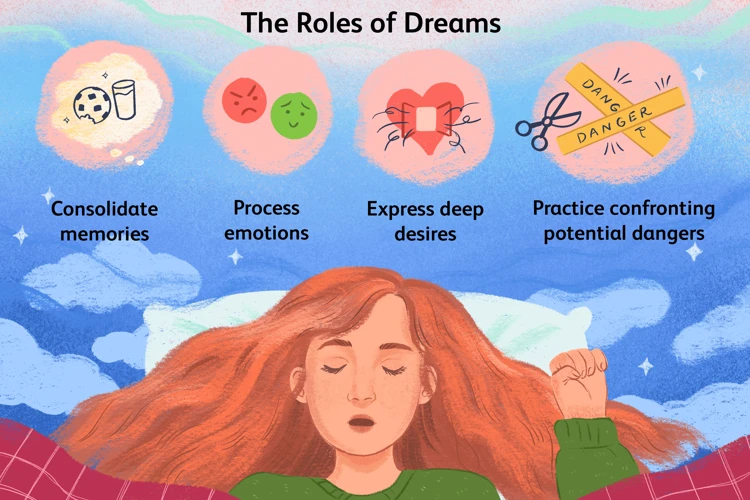Have you ever woken up from a dream that left you feeling bewildered and curious about its meaning? Dreams have long captivated our imagination and sparked our desire to unlock their hidden messages. Whether they are filled with bizarre scenarios, fantastical creatures, or surreal landscapes, wild dreams can hold significant insights into our subconscious minds. In this article, we will delve into the world of dream interpretation and explore the step-by-step process of deciphering the enigmatic symbolism and psychology behind your wildest dreams. Get ready to embark on a journey of self-discovery as we unravel the mysteries that lie within the realms of your sleeping mind.
The Significance of Dreams

Dreams have been a source of fascination and intrigue since the dawn of human history. They hold a significant place in various cultures, religions, and belief systems. The significance of dreams lies in their ability to provide valuable insights into our subconscious mind. They serve as a gateway to our deepest desires, fears, and emotions, often unveiling hidden aspects of ourselves that may remain dormant during our waking hours. Dreams can serve as a source of inspiration, guidance, and self-reflection. By unraveling the symbolism and messages contained within our dreams, we gain a better understanding of ourselves and can unlock the untapped potential of our inner worlds.
Understanding Wild Dreams

Understanding wild dreams requires a closer examination of their unique characteristics and recurring themes. When it comes to types of wild dreams, they can range from vivid, extraordinary adventures to eerie, unsettling experiences. Dreams of flying, falling, or being chased are common examples. Additionally, wild dreams often feature bizarre scenarios, unusual objects, and fantastical creatures. By recognizing these patterns and themes, we can begin to unravel the symbolism and deeper meanings behind our wild dreams. Some common themes in wild dreams include being unprepared for an important event, experiencing sudden transformations, or confronting fears and anxieties. Through careful analysis and interpretation, we can unlock the hidden messages and profound insights that these wild dreams hold, guiding us on our journey of self-discovery.
1. Types of Wild Dreams
Wild dreams encompass a vast array of experiences that can vary greatly from person to person. These dreams can be categorized into different types based on their content and themes. One type of wild dream is the lucid dream, where the dreamer becomes aware that they are dreaming and can actively participate in and manipulate the dream. Nightmares, on the other hand, are intense and emotionally distressing dreams that invoke fear, anxiety, or a sense of danger. Prophetic dreams are those that seemingly predict future events or offer glimpses into the unknown. Recurring dreams, as the name suggests, occur repeatedly, often portraying similar scenarios or themes. Exploring the different types of wild dreams can help individuals better understand and navigate their impact on the subconscious mind.+
2. Common Themes in Wild Dreams
When it comes to wild dreams, there are certain common themes that tend to recur across different individuals. These themes often reflect universal experiences and emotions. One common theme is falling, which can symbolize a loss of control or a fear of failure. Another prevalent theme is being chased, representing a sense of vulnerability or the need to confront a problem. Flying, on the other hand, signifies freedom and empowerment. Other common themes include being naked, which relates to vulnerability and self-acceptance, and teeth falling out, which may symbolize anxiety or a fear of losing something important. Exploring these recurring themes in wild dreams can provide valuable insights into our underlying emotions and concerns.
Interpreting Symbolism in Wild Dreams

Interpreting the symbolism in wild dreams is like deciphering a secret code that holds the key to unlocking our subconscious mind. The objects and animals that appear in our dreams often carry hidden meanings and messages. To understand these symbols, we can analyze them in two ways. First, we can look at the objects and animals themselves, considering their traditional cultural or personal significance. For example, a snake may represent transformation or hidden desires. Secondly, we can examine the events and actions that take place in the dream. Are we running away from something? Falling? Flying? These actions can indicate underlying fears, desires, or challenges in our waking life. By carefully analyzing the symbolism of our wild dreams, we can gain valuable insights and a deeper understanding of our inner selves.
1. Analyzing Objects and Animals
When analyzing objects and animals in our dreams, it is important to pay attention to the specific details and qualities associated with them. Objects can symbolize various aspects of our lives, such as personal belongings representing our sense of identity or tools symbolizing our skills and abilities. Animals, on the other hand, often represent our instincts, emotions, or certain personality traits. For example, a lion may symbolize courage and strength, while a snake could represent hidden fears or transformation. By carefully examining these symbols and their personal significance, we can gain a deeper understanding of the hidden messages our dreams are trying to convey.
2. Decoding Events and Actions
Decoding the events and actions within wild dreams is an essential step in understanding their meaning. Every action, event, or sequence in a dream carries its own symbolic significance. Analyzing the events that unfold can provide valuable insights into our waking life situations, emotions, and unresolved conflicts. For example, being chased in a dream may represent the feeling of being pursued or avoiding a problem in our waking lives. Falling can signify a loss of control or fear of failure. By deciphering the meaning behind these events and actions, we can gain a deeper understanding of ourselves and the underlying messages our dreams are trying to convey.
Diving into the Psychology of Wild Dreams

Diving into the psychology of wild dreams allows us to explore the depths of our subconscious mind and unravel the intricate workings of our thoughts, emotions, and experiences. One aspect of wild dreams is their ability to reveal unconscious desires and repressed emotions. These dreams can serve as a safe space for our subconscious to express and process these hidden aspects of ourselves. Additionally, wild dreams often manifest fear and anxiety, providing a unique opportunity to confront and better understand these emotions in a controlled environment. They can act as a release valve for the anxieties we experience in our waking lives, helping us manage and overcome them. Another fascinating aspect of wild dreams is their reflection of past experiences. They may resurface memories, connections, and traumas that we may have buried or forgotten, allowing us to gain new insights and perspectives. By exploring the psychology of wild dreams, we can gain a deeper understanding of ourselves and our innermost thoughts and feelings.
1. Unconscious Desires and Repressed Emotions
Unconscious desires and repressed emotions often find expression in our wild dreams. Our dreams can provide a platform for these hidden feelings to surface. They may reveal our suppressed desires, unfulfilled wishes, or unresolved conflicts. For example, dreaming of flying may symbolize a desire for freedom or a longing for escape. Likewise, nightmares could be manifestations of anxieties and unresolved traumas. These dreams act as a means for our subconscious mind to process and confront these deep-rooted emotions. By paying close attention to the themes, symbols, and emotions in our wild dreams, we can gain valuable insights into our unconscious desires and repressed emotions, ultimately leading to personal growth and self-awareness.
2. Fear and Anxiety Manifestations
Fear and anxiety manifestations in wild dreams can often be intense and startling. These dreams serve as a platform for our subconscious to process and confront our deepest fears and anxieties. Common manifestations may include being chased, experiencing a feeling of helplessness, or encountering threatening figures. These dreams provide an opportunity to acknowledge and confront our fears in a safe environment. By analyzing the symbolism and emotions within these dreams, we can gain valuable insights into the underlying causes of our anxieties and work towards overcoming them. It is important to approach these dreams with compassion and curiosity, allowing ourselves to explore and understand the root of our fears.
3. Reflections of Past Experiences
Our dreams have a remarkable way of reflecting our past experiences and memories. When we dream, our subconscious mind draws upon stored information and replays it in various forms. These dreams can bring back vivid recollections of events, places, and people from our past. They may serve as a means of processing and integrating past traumas, unresolved conflicts, or moments of joy and happiness. Dreams can also offer us a different perspective on past experiences, allowing us to view them through the lens of our subconscious mind. By exploring these reflections of past experiences, we can gain valuable insights and a deeper understanding of ourselves and our personal history.
Consulting Experts on Dream Interpretation

When it comes to deciphering the complex language of dreams, seeking guidance from experts in the field can be immensely helpful. There are several professionals with specialized knowledge in the realm of dream interpretation. Psychoanalysts play a crucial role in uncovering the deeper meanings behind our dreams. Through techniques such as dream analysis and free association, they aim to connect the symbols and events in dreams to our unconscious desires and repressed emotions. Neuroscientists bring a scientific perspective to the study of dreams, using brain imaging and neurological research to gain insights into the physiological processes that occur during dreaming. Lastly, spiritual leaders and practitioners offer interpretations based on metaphysical or religious beliefs, harnessing the power of symbolism and spirituality to shed light on the messages conveyed in dreams. Consulting these experts can provide valuable perspectives and guidance in our journey to understand the significance of our dreams.
1. Role of Psychoanalysts
Psychoanalysts play a crucial role in the interpretation and analysis of dreams. Drawing from the theories of Sigmund Freud, they believe that dreams are a manifestation of unconscious desires and repressed emotions. Through techniques such as free association and dream analysis, psychoanalysts help individuals explore the hidden symbolism and underlying meanings of their dreams. They examine the various elements, images, and emotions present in the dream narrative to shed light on the individual’s inner conflicts, wishes, and unresolved issues. By unraveling the complexities of the dream content, psychoanalysts provide invaluable insights into the deeper psychological aspects of a person’s life.
2. Insights from Neuroscientists
Insights from neuroscientists play a vital role in understanding the complexities of dreams. They have discovered that during the REM (rapid eye movement) stage of sleep, the brain experiences heightened activity, similar to that of wakefulness. This period is when vivid dreaming occurs. Neuroscientists have used advanced imaging techniques to study the brain during sleep, uncovering connections between different regions and their involvement in dream formation. They have found that various brain regions, including the hippocampus and amygdala, play significant roles in memory consolidation, emotional processing, and the creation of dream scenarios. These insights provide valuable scientific perspectives on the neural processes underlying dreams, offering a deeper understanding of why and how we dream.
3. Contributions of Spiritual Leaders
Spiritual leaders have long recognized the profound significance of dreams and have made notable contributions to the field of dream interpretation. They offer unique perspectives and insights into the spiritual and metaphysical dimensions of dreams. Some spiritual leaders believe that dreams are a powerful tool for connecting with the divine and receiving guidance from higher realms. They often emphasize the importance of cultivating a spiritual practice, such as meditation or prayer, to enhance dream recall and facilitate the interpretation process. These leaders encourage individuals to view dreams as sacred messages that can provide profound revelations and serve as a means of spiritual growth and transformation.
Practical Tips for Deciphering Wild Dreams
Deciphering wild dreams can be a fascinating and enlightening process. To aid in this endeavor, here are some practical tips to help unravel the hidden meanings within your dreams. Keeping a dream journal is an invaluable tool as it allows you to record your dreams immediately upon waking, capturing as many details as possible. Analyzing patterns and recurring symbols in your dreams can provide insights into recurring themes and emotions in your subconscious. Additionally, seeking inner reflection and meditation can create a space for deeper self-awareness and understanding of your dreams. By combining these tips and techniques, you can embark on a journey of self-discovery and unlock the rich tapestry of symbolism and meaning within your wild dreams.
1. Keeping a Dream Journal
One effective way to decipher the meaning of wild dreams is by keeping a dream journal. This involves documenting your dreams as soon as you wake up, capturing as many details as possible. By recording your dreams regularly, you can identify recurring patterns, symbols, and themes, which can provide valuable insights into your subconscious mind. A dream journal can be in the form of a notebook, a digital app, or even just a voice recording. The key is to make it a habit and commit to writing down your dreams consistently. When journaling, be sure to include specific details such as emotions, colors, people, and any significant objects or actions that stood out. By revisiting your dream journal over time, you may begin to notice connections and symbolism that can aid in unraveling the meaning behind your wildest dreams.
2. Analyzing Patterns and Recurring Symbols
When deciphering the meaning of your wild dreams, it is important to pay attention to patterns and recurring symbols that may appear throughout your dreamscape. These patterns and symbols often carry significant meaning and can provide valuable insights into the messages your subconscious mind is trying to convey. Analyzing these patterns can help you identify common themes, emotions, or situations that are recurring in your dreams. By taking note of these patterns and symbols in a dream journal, you can start to piece together the puzzle of your dream world, uncovering underlying meanings that may be guiding you towards self-discovery and personal growth.
3. Seeking Inner Reflection and Meditation
Seeking inner reflection and practicing meditation can be powerful tools in deciphering the meaning of your wildest dreams. By engaging in regular meditation practices, you can cultivate a heightened sense of self-awareness and a deeper connection to your subconscious mind. This facilitates a greater ability to recall and analyze your dreams. During meditation, you can focus on specific dream symbols or themes that have appeared in your wild dreams, allowing them to surface in your consciousness. Through a state of deep relaxation and mindfulness, you can explore the emotions, thoughts, and sensations associated with your dreams, leading to profound insights and understanding. Meditation also provides a space for contemplation and introspection, where you can ponder the meaning and significance of your dreams in the larger context of your life. By combining inner reflection and meditation, you can tap into the hidden wisdom of your dreams and unlock their true meaning.
Conclusion
In conclusion, delving into the meaning of our wildest dreams can be a captivating journey of self-discovery. By understanding the significance of dreams, deciphering their symbolism, exploring the psychology behind them, and consulting experts on dream interpretation, we can gain valuable insights into our subconscious mind. With practical tips such as keeping a dream journal, analyzing patterns and recurring symbols, and seeking inner reflection and meditation, we can unlock the hidden messages and wisdom that our dreams offer. So, embrace the enigmatic world of your dreams and allow them to guide you on a path of self-awareness, growth, and understanding. Your wildest dreams may just hold the key to unlocking the mysteries of your own mind.
Frequently Asked Questions
1. Can dreams predict the future?
While some people claim to have experienced prophetic dreams, the scientific evidence for dreams predicting the future remains inconclusive. Dreams are generally considered to be a reflection of our thoughts, emotions, and experiences.
2. Why do we forget our dreams?
Forgetting dreams is a common phenomenon due to the brain’s natural process of filtering and prioritizing information. Dreams are stored in short-term memory, and without conscious effort to remember them, they can quickly fade.
3. Are nightmares a sign of psychological issues?
Nightmares can be a manifestation of stress, anxiety, or unresolved trauma. However, they are not necessarily an indication of a psychological disorder. It’s important to consider the context and frequency of nightmares before drawing conclusions.
4. Do animals have dreams?
Studies have shown that several animal species, including mammals and birds, exhibit brain activity similar to REM sleep, indicating the possibility of dreaming. However, since animals cannot communicate their dreams, it remains a subject of scientific speculation.
5. Can we control our dreams?
Lucid dreaming is a state where individuals become aware that they are dreaming and can exert some control over the dream’s content. It is a skill that can be developed through various techniques and practices, such as reality checks and dream journaling.
6. Do all dreams have meaning?
While all dreams have significance as reflections of our subconscious mind, not all dreams have a profound or symbolic meaning. Some dreams may simply be a result of random neural activity or the processing of daily experiences.
7. Are there universal symbols in dreams?
Certain symbols, such as water, flying, or falling, are commonly reported across different cultures and may have universal meanings. However, the interpretation of symbols in dreams also depends on personal experiences, beliefs, and cultural influences.
8. Can dream interpretation be subjective?
Yes, dream interpretation can be subjective as it relies on personal associations, experiences, and emotions. Different individuals may interpret the same dream symbol in various ways based on their unique perspectives.
9. Do recurring dreams have a special significance?
Recurring dreams often indicate unresolved issues, fears, or recurring patterns in one’s life. They can serve as a wake-up call to pay attention to certain aspects of your waking life that may require attention or resolution.
10. Can dreams help with problem-solving?
Research suggests that dreams can contribute to problem-solving and creative thinking. Dreams provide a safe space for the brain to process information, make connections, and generate innovative ideas that may not have occurred during waking hours.

